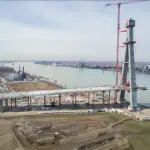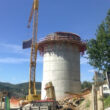China is renowned for its ambitious infrastructure projects, and the Wuhan-Yangxin Highway in Hubei Province is no exception. This 126-kilometer highway stands as a remarkable feat of engineering, seamlessly blending modern transportation needs with environmental preservation. Spanning over rice fields and aquaculture ponds, its elevated design ensures smooth traffic flow while safeguarding agricultural activities. More than just a road, it exemplifies how development and nature can coexist in perfect harmony.

A Floating Highway Over Water
One of the most striking features of the Wuhan-Yangxin Highway is its elevated structure, which appears to “float” over a vast expanse of water. From an aerial view, the highway looks like a ribbon of concrete weaving through a mosaic of rice paddies and fish farms, creating a breathtaking visual spectacle. This design is not merely aesthetic—it serves a critical purpose by minimizing the impact on agricultural lands and aquatic ecosystems.
Engineering Excellence and Design
The highway is designed for a maximum speed of 100 km/h, ensuring efficient transportation between Wuhan and Yangxin. Its elevated structure was carefully planned to avoid disrupting existing farmlands and water bodies, allowing local farmers and fishery workers to continue their traditional activities uninterrupted. Unlike conventional roadways that often require large-scale land clearance, this approach preserves the delicate balance between development and nature.
Economic and Social Benefits
Beyond its engineering brilliance, the Wuhan-Yangxin Highway plays a significant role in boosting the local economy. By enhancing connectivity between Wuhan, a major economic hub, and Yangxin, a region rich in agricultural resources, the highway facilitates the transportation of goods and people. This improved accessibility has led to increased trade opportunities, tourism growth, and overall regional development, benefiting both urban and rural communities.
Environmental Considerations
The highway’s construction showcases China’s growing commitment to sustainable development. Traditional infrastructure projects often come at the cost of environmental degradation, but this highway proves that innovation can be eco-friendly. By avoiding large-scale land disruption and allowing nature to thrive beneath its elevated structure, the Wuhan-Yangxin Highway sets an example for future infrastructure projects worldwide.
A New Model for Infrastructure Development
The Wuhan-Yangxin Highway is more than just a transportation route—it is a symbol of how modern engineering can respect and preserve traditional landscapes. It demonstrates that progress does not have to come at the expense of the environment. As China continues to push the boundaries of infrastructure development, this project serves as a blueprint for integrating technology with ecological responsibility.
Conclusion
In an era where infrastructure development often clashes with environmental concerns, the Wuhan-Yangxin Highway offers a refreshing perspective. By combining cutting-edge engineering with a deep respect for nature, it transforms an ordinary journey into a scenic experience. Whether viewed from the ground or the air, this highway stands as a testament to the possibilities of sustainable progress, proving that innovation and tradition can indeed go hand in hand.





















